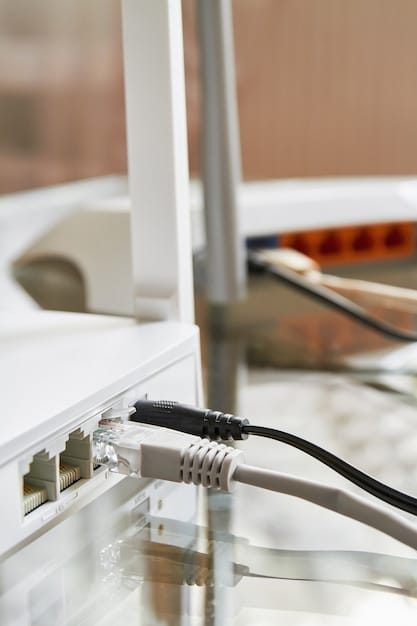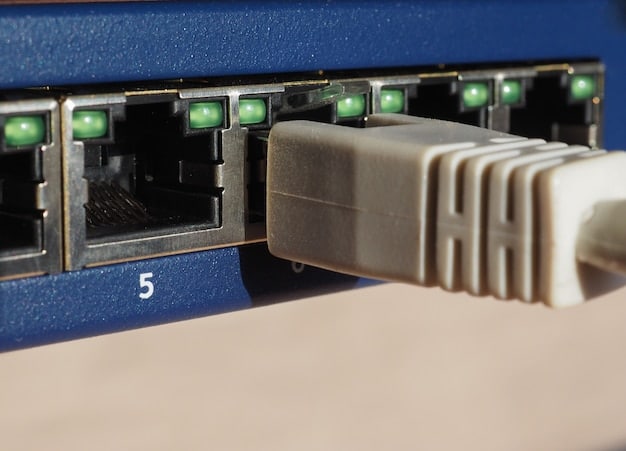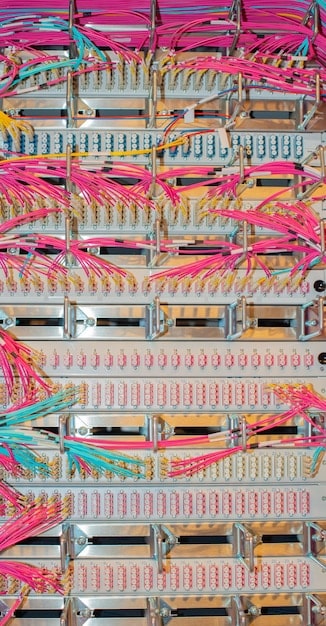Upgrade to Gigabit Ethernet: Your Complete Home Network Guide

Upgrading your home network to Gigabit Ethernet involves replacing older network components with newer, faster ones to achieve wired data transfer speeds up to 1 Gbps, significantly improving performance for bandwidth-intensive applications.
Ready to boost your home network’s speed and reliability? This guide walks you through a complete upgrade your home network to Gigabit Ethernet, step by step.
Understanding Gigabit Ethernet and Its Benefits
Gigabit Ethernet has become the standard for modern home networks, offering a significant speed boost over older standards. It’s essential to understand what it is and why it’s beneficial before diving into the upgrade process.
Let’s explore the technology and the advantages it provides.
What is Gigabit Ethernet?
Gigabit Ethernet refers to a networking technology that provides data transfer rates of up to 1 Gigabit per second (Gbps), or 1,000 Megabits per second (Mbps). This is a substantial increase compared to older standards like Fast Ethernet, which offers only 100 Mbps. This improvement in speed translates to faster file transfers, smoother streaming, and an overall better online experience.
Key Benefits of Upgrading
There are numerous benefits to upgrading to Gigabit Ethernet, making it a worthwhile investment for any home network. From improved speed to enhanced reliability, here’s why you should consider making the switch.
- Faster Data Transfer: Speeds up file sharing, backups, and media streaming within your home network.
- Improved Streaming Quality: Ensures smooth, buffer-free streaming of high-definition video content.
- Lower Latency: Reduces lag in online gaming and video conferencing, providing a more responsive experience.
- Enhanced Network Performance: Allows multiple devices to operate simultaneously without significant slowdowns.
In summary, Gigabit Ethernet enhances your overall network performance, supporting various bandwidth-intensive applications. It’s a foundational upgrade for modern digital living, providing faster speeds and improved reliability.

Assessing Your Current Network Setup
Before upgrading to Gigabit Ethernet, it’s crucial to assess your current network setup to identify any potential bottlenecks or compatibility issues. Evaluating your existing hardware and infrastructure ensures a smooth and efficient upgrade process.
Here’s how to conduct a thorough assessment.
Check Your Existing Hardware
Start by examining your current network devices. Determine if your router, switches, and network interface cards (NICs) support Gigabit Ethernet. Older devices may only support Fast Ethernet, limiting your network’s potential speed.
Additionally, check the specifications of your devices to confirm their compatibility.
Inspect Your Cabling
The type of Ethernet cables you use also plays a vital role in achieving Gigabit speeds. Older cables, such as Cat5, may not support Gigabit Ethernet, while newer cables like Cat5e, Cat6, and Cat6a are designed for higher bandwidth.
- Cat5e: Supports Gigabit Ethernet over shorter distances.
- Cat6: Offers improved performance and supports Gigabit Ethernet over longer distances.
- Cat6a: Provides even better performance and is recommended for demanding network environments.
Ensure your cables are in good condition, free from damage, and properly connected to prevent signal degradation.
By assessing your current network setup, you can identify the specific components that need to be upgraded, making the transition to Gigabit Ethernet seamless. This proactive approach prevents unexpected issues and ensures optimal network performance.
Essential Hardware and Equipment
Upgrading to Gigabit Ethernet requires specific hardware and equipment to ensure compatibility and optimal performance. Knowing what you need can save you time and money.
Let’s take a look at the essential components.
Gigabit Ethernet Router
The router is the heart of your network, directing traffic and providing internet access. Ensure your router supports Gigabit Ethernet to take full advantage of the increased speeds. Look for routers that specifically advertise Gigabit Ethernet capabilities.
Gigabit Ethernet Switch
A switch is used to connect multiple devices within your local network. To achieve Gigabit speeds, your switch must support Gigabit Ethernet. This allows devices connected to the switch to communicate with each other at Gigabit speeds.
Cat5e, Cat6, or Cat6a Cables
As mentioned earlier, the type of Ethernet cables you use is crucial. Choose Cat5e, Cat6, or Cat6a cables to support Gigabit Ethernet. Cat6 and Cat6a are recommended for their superior performance and ability to handle longer distances.

Gigabit Network Interface Cards (NICs)
Your computers and other devices need Gigabit NICs to connect to the Gigabit Ethernet network. Most modern devices come with Gigabit NICs built-in. However, older devices may need an upgrade. You can purchase Gigabit NICs as add-in cards or USB adapters.
Having the right hardware is essential for a successful upgrade. Make sure each component supports Gigabit Ethernet to unlock the full potential of your network.
Step-by-Step Installation Guide
Now that you have the necessary hardware, it’s time to begin the installation process. This step-by-step guide will walk you through upgrading your home network to Gigabit Ethernet.
Follow these instructions carefully to ensure a smooth installation.
Step 1: Power Down Your Devices
Before starting any hardware changes, power down your router, switch, computers, and other network devices. This prevents electrical damage and ensures safe handling of the equipment.
Step 2: Replace Your Router
Unplug the old router and replace it with the new Gigabit Ethernet router. Connect the Ethernet cable from your modem to the WAN (Wide Area Network) port on the new router. Then, connect the power adapter and turn on the router.
Step 3: Install the Gigabit Ethernet Switch
Connect the Gigabit Ethernet switch to one of the LAN (Local Area Network) ports on your router using a Cat5e, Cat6, or Cat6a cable. Plug in the switch’s power adapter and turn it on. The switch will serve as a central hub for connecting multiple devices.
Step 4: Upgrade Ethernet Cables
Replace all existing Ethernet cables with Cat5e, Cat6, or Cat6a cables. Connect your computers, gaming consoles, smart TVs, and other devices to the Gigabit Ethernet switch. Ensure each connection is secure.
Step 5: Verify Gigabit Ethernet Connection
Turn on your devices and verify that they are connecting to the network. Check your computer’s network settings to confirm that the connection speed is 1 Gbps (Gigabit per second). You may need to update the network driver to ensure proper functionality.
Step 6: Test Your Network Speed
Use online speed test tools to measure your network’s upload and download speeds. Compare the results to your previous speeds to confirm the upgrade’s effectiveness. Ensure that the speeds are consistent and meet your expectations.
By following these steps, you can successfully upgrade your home network to Gigabit Ethernet. Remember to double-check each connection and configuration to ensure optimal performance.
Troubleshooting Common Issues
Even with careful planning and execution, you may encounter some issues during the Gigabit Ethernet upgrade process. This section provides troubleshooting tips for common problems.
Here are some solutions for addressing potential issues.
Slow Connection Speeds
If you’re not seeing the expected Gigabit speeds, check the following:
- Cable Quality: Ensure you’re using Cat5e, Cat6, or Cat6a cables.
- Device Compatibility: Verify that all devices support Gigabit Ethernet.
- Driver Updates: Update your network drivers to the latest versions.
- Router Configuration: Ensure your router is configured to support Gigabit Ethernet.
Intermittent Network Connectivity
Intermittent connectivity can be frustrating. Here’s how to troubleshoot:
- Cable Connections: Check all cable connections to ensure they are secure and properly seated.
- Device Power: Make sure all devices are powered on and functioning correctly.
- Network Interference: Reduce potential interference from other electronic devices.
- Firmware Updates: Update the firmware on your router and switch to the latest versions.
Inability to Connect to the Network
If you can’t connect to the network at all, try these steps:
- Restart Devices: Restart your router, switch, and computers.
- IP Address Configuration: Ensure your devices are obtaining IP addresses automatically.
- Firewall Settings: Check your firewall settings to ensure they are not blocking network traffic.
- Network Diagnostics: Run network diagnostics tools to identify potential problems.
These troubleshooting tips should help you resolve common issues encountered during the Gigabit Ethernet upgrade. Addressing these problems promptly ensures a stable and high-performing home network.
Optimizing Your Gigabit Ethernet Network
Once your Gigabit Ethernet network is up and running, there are several steps you can take to optimize its performance. Fine-tuning your network settings and maintaining your hardware ensures that you get the most out of your upgrade.
Let’s discuss some optimization techniques.
Prioritize Network Traffic with QoS
Quality of Service (QoS) allows you to prioritize certain types of network traffic, such as streaming video or online gaming, ensuring they receive preferential treatment. This can help reduce lag and improve the overall experience.
Keep Firmware Updated
Regularly update the firmware on your router and switch to benefit from the latest performance improvements and security patches. Firmware updates often include optimizations that can enhance network performance and stability.
Regularly Check and Replace Cables
Inspect your Ethernet cables periodically for damage and replace any that are worn or faulty. Damaged cables can cause signal degradation and reduce network performance.
Use a Network Monitoring Tool
Employ a network monitoring tool to track your network’s performance and identify potential bottlenecks or issues. These tools provide real-time data on network traffic, device connectivity, and other important metrics.
By optimizing your Gigabit Ethernet network, you can ensure it operates at peak performance, delivering the speed and reliability you need for all your online activities. Consistent maintenance and proactive monitoring are key to long-term success.
| Key Aspect | Brief Description |
|---|---|
| 🚀 Gigabit Ethernet | Networking technology with speeds up to 1 Gbps. |
| 🛠️ Hardware | Requires Gigabit router, switch, and Cat5e or better cables. |
| 💡 Troubleshooting | Check cables, update drivers, and verify device compatibility. |
| ⚙️ Optimization | Prioritize traffic with QoS, update firmware, and monitor network performance. |
Frequently Asked Questions
Gigabit Ethernet is a network standard capable of data transfer rates up to 1 Gbps. Upgrading provides faster speeds for file sharing, streaming, and online gaming, enhancing overall network performance and user experience.
You should use Cat5e, Cat6, or Cat6a cables for Gigabit Ethernet. Cat5e is sufficient for shorter distances, while Cat6 and Cat6a offer better performance and are recommended for longer cable runs.
Check the specifications of your devices or the product manual. Most modern devices have built-in Gigabit Ethernet support. For older devices, you may need to install a Gigabit Network Interface Card (NIC).
Common issues include slow connection speeds, intermittent network connectivity, and the inability to connect to the network. These can often be resolved by checking cable connections, updating drivers, and restarting devices.
Optimize your network by implementing Quality of Service (QoS), keeping firmware updated, regularly checking and replacing cables, and using network monitoring tools to identify and resolve any performance bottlenecks.
Conclusion
Upgrading your home network to Gigabit Ethernet is a worthwhile investment for improved speed, reliability, and overall performance. By following this comprehensive guide, you can ensure a smooth transition and enjoy the benefits of a faster, more efficient network.





